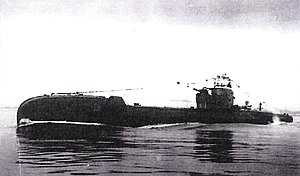HMS Totem (P352)

HMS Totem in Plymouth Sound, December 1944
|
|
| History | |
|---|---|
| Name: | HMS Totem |
| Ordered: | 1941 |
| Builder: | HM Dockyard Devonport |
| Laid down: | 22 October 1942 |
| Launched: | 28 September 1943 |
| Commissioned: | 9 January 1945 |
| Identification: | Pennant number: P352 |
| Fate: | Sold to the Israeli Navy in 1965 |
| Badge: | |
| General characteristics | |
| Class and type: | T-class submarine |
| Displacement: |
|
| Length: | 276 ft 6 in (84.28 m) |
| Beam: | 25 ft 6 in (7.77 m) |
| Draught: |
|
| Propulsion: |
|
| Speed: |
|
| Range: | 4,500 nautical miles at 11 knots (8,330 km at 20 km/h) surfaced |
| Test depth: | 300 ft (91 m) max |
| Complement: | 61 |
| Armament: |
|
HMS Totem was a Group 3 T-class submarine of the Royal Navy which entered service in the last few months of World War II. To-date, she is the only ship of the Royal Navy to have been named Totem.
Totem was sold to Israel in 1965 and commissioned into the Israeli Sea Corps in 1967 as INS Dakar. She sank whilst on passage from the United Kingdom to Israel in January 1968.
The submarine was presented with a totem pole by the Cowichan Tribes in 1945, which was stolen during the 1950s when the boat was visiting Halifax, Canada. The pole was fitted to the front of the bridge fin when the submarine was in harbour.
At the end of the war, all surviving T-class Group 1 and Group 2 boats were scrapped, but the Group 3 boats (which were of welded rather than riveted construction) were retained and fitted with snorkel masts.
In January 1948 it was formally acknowledged that the main operational function of the British submarine fleet would now be to intercept Soviet submarines slipping out of their bases in Northern Russia to attack British and Allied merchant vessels. The following April, the Assistant Chief of Naval Staff, Rear-Admiral Geoffrey Oliver circulated a paper in which he proposed that British submarines take a more offensive role by attacking Soviet submarines off the Northern Russian coast and mining the waters in the area. With the surface fleet dramatically reduced following the end of the Second World War, he commented that this was one of the few methods the Royal Navy had for "getting to the enemy on his home ground".
To fulfil this new role, Totem was one of eight boats which were extensively modified to become "super T-conversions", giving them higher speed and quieter operation underwater. Five further T-class submarines were given much less extensive streamlining improvements.
The work on Totem was done between 1951 and May 1953 at Chatham Dockyard (which carried out all eight super T-conversions), and involved inserting an additional hull section 14 feet (4.3 m) long to accommodate extra switchgear and an extra pair of electric motors and replacing the batteries. The hull was streamlined, which included the removal of the deck gun and the replacement of the bridge fin with one which was taller, enclosing the periscopes and masts. The radar and sonar were updated at the same time. After the submarine had returned to service, her top speed exceeded 18 knots (33 km/h), aided by the unofficial removal in the dockyard at Malta of the housing for the airguard radar aerial which added 3/4 knot to her top speed.
...
Wikipedia

